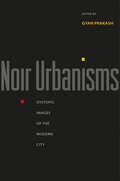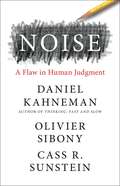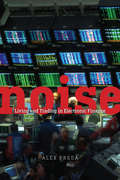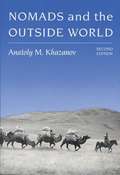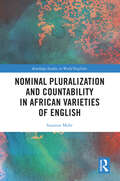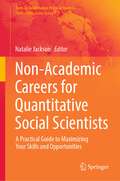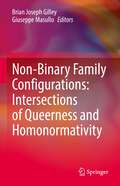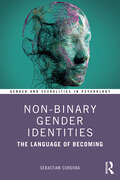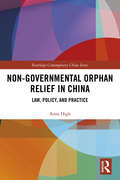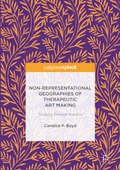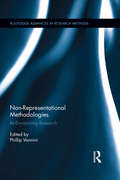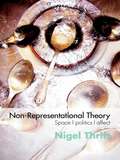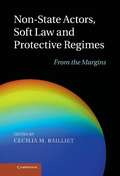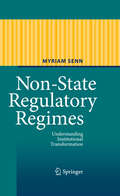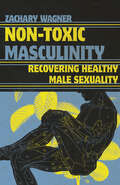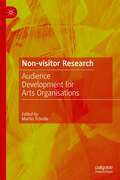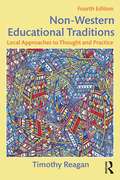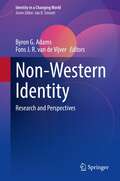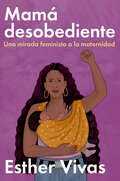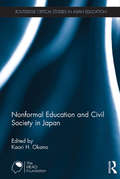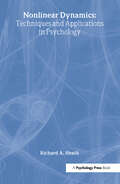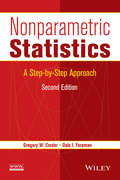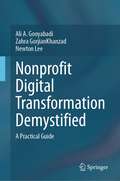- Table View
- List View
Nochixtlán: Un domingo negro. Radiografía de una masacre
by Emma Landeros MartínezUna denuncia frontal y estricta que señala los abusos de las fuerzas armadas, la imposición criminal como diálogo y la matanza como marca del gobierno de Peña Nieto. La mañana del 19 de junio de 2016 se dio en Nochixtlán uno de los ataques más terribles de las fuerzas armadas contra maestros y la población de este pueblo. Con alevosía, las policías local, federal y la gendarmería tomaron por asalto el pueblo de Oaxaca. No hubo enfrentamiento: maestros y población no tenían armas y nada impidió los centenares de balazos por aire y tierra. Con base en numerosas entrevistas a las víctimas y familiares de los asesinados, con las voces de los niños y parientes que huyeron ante la embestida de los gases lacrimógenos, además de un registro fotográfico y la consulta de numerosas fuentes periodísticas, Emma Landeros Martínez detalla lo que en realidad pasó aquel "Día del padre" en Nochixtlán, qué suerte corrieron las víctimas y cómo se acomodaron los hechos las semanas siguientes marcadas por la indolencia política, la injusticia y la crueldad del olvido social. La periodista nos revela por qué es tan importante para el gobierno de Peña Nieto someter de esa manera a la población; confronta la opinión del gobierno ante la masacre, desenmascara su versión oficial, incluso desafía las declaraciones de la Comisión Nacional de Derechos Humanos, que en este caso parece trabajar a las órdenes del gobierno represor. Nochixtlán es la voz de víctimas e inocentes que se eleva para mostrar su sangre, su dolor e indignación.
Noir Urbanisms: Dystopic Images of the Modern City
by Gyan PrakashDystopic imagery has figured prominently in modern depictions of the urban landscape. The city is often portrayed as a terrifying world of darkness, crisis, and catastrophe. Noir Urbanisms traces the history of the modern city through its critical representations in art, cinema, print journalism, literature, sociology, and architecture. It focuses on visual forms of dystopic representation--because the history of the modern city is inseparable from the production and circulation of images--and examines their strengths and limits as urban criticism. Contributors explore dystopic images of the modern city in Germany, Mexico, Japan, India, South Africa, China, and the United States. Their topics include Weimar representations of urban dystopia in Fritz Lang's 1927 film Metropolis; 1960s modernist architecture in Mexico City; Hollywood film noir of the 1940s and 1950s; the recurring fictional destruction of Tokyo in postwar Japan's sci-fi doom culture; the urban fringe in Bombay cinema; fictional explorations of urban dystopia in postapartheid Johannesburg; and Delhi's out-of-control and media-saturated urbanism in the 1980s and 1990s. What emerges in Noir Urbanisms is the unsettling and disorienting alchemy between dark representations and the modern urban experience. In addition to the editor, the contributors are David R. Ambaras, James Donald, Rubén Gallo, Anton Kaes, Ranjani Mazumdar, Jennifer Robinson, Mark Shiel, Ravi Sundaram, William M. Tsutsui, and Li Zhang.
Noise: A Flaw in Human Judgment
by Cass R. Sunstein Daniel Kahneman Olivier SibonyFrom the Nobel Prize-winning author of Thinking, Fast and Slow and the coauthor of Nudge, a revolutionary exploration of why people make bad judgments and how to make better ones--"full of novel insights, rigorous evidence, engaging writing, and practical applications” (Adam Grant). Imagine that two doctors in the same city give different diagnoses to identical patients—or that two judges in the same courthouse give markedly different sentences to people who have committed the same crime. Suppose that different interviewers at the same firm make different decisions about indistinguishable job applicants—or that when a company is handling customer complaints, the resolution depends on who happens to answer the phone. Now imagine that the same doctor, the same judge, the same interviewer, or the same customer service agent makes different decisions depending on whether it is morning or afternoon, or Monday rather than Wednesday. These are examples of noise: variability in judgments that should be identical. In Noise, Daniel Kahneman, Olivier Sibony, and Cass R. Sunstein show the detrimental effects of noise in many fields, including medicine, law, economic forecasting, forensic science, bail, child protection, strategy, performance reviews, and personnel selection. Wherever there is judgment, there is noise. Yet, most of the time, individuals and organizations alike are unaware of it. They neglect noise. With a few simple remedies, people can reduce both noise and bias, and so make far better decisions. Packed with original ideas, and offering the same kinds of research-based insights that made Thinking, Fast and Slow and Nudge groundbreaking New York Times bestsellers, Noise explains how and why humans are so susceptible to noise in judgment—and what we can do about it.
Noise: Living and Trading in Electronic Finance
by Alex PredaWe often think of finance as a glamorous world, a place where investment bankers amass huge profits in gleaming downtown skyscrapers. There’s another side to finance, though—the millions of amateurs who log on to their computers every day to make their own trades. The shocking truth, however, is that less than 2% of these amateur traders make a consistent profit. Why, then, do they do it? In Noise, Alex Preda explores the world of the people who trade even when by all measures they would be better off not trading. Based on firsthand observations, interviews with traders and brokers, and on international direct trading experience, Preda’s fascinating ethnography investigates how ordinary people take up financial trading, how they form communities of their own behind their computer screens, and how electronic finance encourages them to trade more and more frequently. Along the way, Preda finds the answer to the paradox of amateur trading—the traders aren’t so much seeking monetary rewards in the financial markets, rather the trading itself helps them to fulfill their own personal goals and aspirations.
Nomads and the Outside World, Second Edition
by Anatoly M. Khazanov Julia CrookendenHailed by reviewers as "majestic and magisterial," Nomads and the Outside World was first published in English in 1984. With the author's new introduction and an updated bibliography, this classic is now available in an edition accessible to students. From reviews of the first edition: "Magisterial. . . . Combining a phenomenal erudition, a candid judgment, and a subtle sense of irony, Khazanov sets out to challenge the orthodox view of nomadic feudalism and, in the process, has produced the first comparative survey of pastoral societies that can claim to be truly comprehensive, covering their history in Eurasia, the Middle East, and Africa from the origins of pastoralism to the dawn of the modern era. "--Tim Ingold, Current Anthropology "This is the best study on pastoral nomadism that the reviewer has ever read. At last we have a major attempt to present the whole phenomenon in historical, ecological, spatial and structural perspective. . . . Superb scholarship. It is the kind of work that can only be produced as a result of years of specific research, much deep thinking . . . and a determination to reject cant. "--John C. Wilkinson, Geographical Journal "Khazanov's book on pastoral nomadism is a heroic endeavor of a kind no one has seriously attempted before. . . . Particularly valuable to western readers are the materials on the numerous peoples of Central Asia and Siberia . . . and their integration with analysis of more familiar societies such as those of North and East Africa and the Middle East. . . . The insights provided by this book are too numerous to list. "--Caroline Humphrey, Times Literary Supplement
Nominal Pluralization and Countability in African Varieties of English (Routledge Studies in World Englishes)
by Susanne MohrThis book is the first comprehensive analysis of nominal plural marking, its morphosyntax and semantics, across different African varieties of English. Mohr explores the rich diversity in the varieties and how different conceptualizations of the number category are realized across different cultures. The investigation of unstandardized noun plurals in Kenyan, Tanzanian, Ghanaian and Nigerian Englishes is based on a mixed methods design drawing on corpus linguistics, acceptability questionnaires and psycholinguistic experiments. In this vein, the book not only contributes to the description of each of these four varieties, but also sheds light on standardization processes and language change in New Englishes. Importantly, it is a plea for the triangulation of data and mixed methods approaches in World Englishes research, as the combination of these methods grants insight into unforeseen areas of language structures and use. This volume is a useful reference work for students and researchers in World Englishes, varieties of English and African Studies, as well as those interested in linguistic anthropology.
Non-Academic Careers for Quantitative Social Scientists: A Practical Guide to Maximizing Your Skills and Opportunities (Texts in Quantitative Political Analysis)
by Natalie JacksonThis book is a guide to non-academic careers for quantitative social scientists. Written by social science PhDs working in large corporations, non-profits, tech startups, and alt-academic positions in higher education, this book consists of more than a dozen chapters on various topics on finding rewarding careers outside the academy. Chapters are organized in three parts. Part I provides an introduction to the types of jobs available to social science PhDs, where those jobs can be found, and what the work looks like in those positions. Part II creates a guide for social science PhDs on how to set themselves up for such careers, including navigating the academic world of graduate school while contemplating non-academic options, and selling their academic experience in a non-academic setting. Part III offers perspectives on timelines for making non-academic career decisions, lifestyle differences between academia and non-academic jobs, and additional resources for those considering a non-academic route. Providing valuable insight on non-academic careers from those who have successfully made the transition, this volume will be an asset to graduate students, advisors, and recent PhDs, in quantitative social science.
Non-Binary Family Configurations: Intersections of Queerness and Homonormativity
by Brian Joseph Gilley Giuseppe MasulloThis volume provides a close look at the ways in which LGBTQ2 people form familial bonds. It brings together stories from non-binary families across continents and cultures and recenters care as a foundational value for creating familial ties. This volume therefore addresses a gap in the literature concerning non-binary family configurations by going beyond the legal battle for non-binary partnership rights. In recent discussions on marriage equality, the notion of familial bonds, which was important in early discussions on non-binary family research, has been decentered in favor of legal and homonormative understandings of individual rights. This volume centers familial bonds as the first step toward reimagining how to do research on the family and adds to research on family studies as well as gender studies.Students and researchers of sociology, anthropology, social work, gender studies, family research, well-being research, and anyone else working on or with non-binary families will find this book highly topical and interesting.
Non-Binary Gender Identities: The Language of Becoming (Gender and Sexualities in Psychology)
by Sebastian CordobaNon-Binary Gender Identities examines how non-binary people discover, adopt, and negotiate language in a variety of social settings, both offline and online. It considers how language, in the form of gender-neutral pronouns, names, and labels, is a central aspect of identity for many and has been the subject of much debate in recent years. Cordoba captures the psychological, social, and linguistic experiences of non-binary people by illustrating the multiple, complex, and evolving ways in which non-binary people use language to express their gender identities, bodies, authenticity, and navigate social interactions – especially those where their identities are not affirmed. These findings shed light on the gender and linguistic becomings of non-binary people, a pioneering theoretical framework developed in the book, which reflects the dynamic realities of language, subjectivities, and the materiality of the body. Informed by these findings, the text offers recommendations for policy makers and practitioners, designed to facilitate gender-related communication and decrease language-related distress on non-binary people, as well as the general population. This important book advances our understanding of non-binary gender identities by employing innovative methodologies – including corpus-based research and network visualisation – furthering and developing theory, and yielding original insights. It is essential reading for students and academics in social psychology and gender studies, as well as anyone interested in furthering their understanding of non-binary gender identities.
Non-Governmental Orphan Relief in China: Law, Policy, and Practice (Routledge Contemporary China Series)
by Anna HighBased on field studies and in-depth interviews across rural and urban China, this book presents a socio-legal analysis of non-state organised care for some of China's most vulnerable children. The first full-length book to examine non-state organised care of modern China's ‘lonely children’ (gu'er), this book describes the context in which abandonment occurs and the care provided to children unlikely to be adopted because of their disability. It also explores the various faith groups and humanitarian workers providing this care in private orphanages and foster homes in response to perceived deficiencies in the state orphanage system, in the context of a broader societal shift from ‘welfare statism’ to ‘welfare pluralism’. Formal law and policy has not always kept pace with this shift. This study demonstrates that, in practice, state regulation of these unauthorised care providers has mostly centred on local-level negotiations, hidden rules, and discretion, with mixed outcomes for children. However there has also been a recent shift towards tighter state control and clearer laws, policies, and standards. This timely research sheds light on the life paths and stories of today's ‘lonely children’ and the changing terrain of civil society, humanitarianism, policy-making, and state power in modern China. As such, this book will appeal to students and scholars of Asian and Chinese studies, law and society, NGOs, and comparative social and child welfare.
Non-Governmental Public Action and Social Justice
by Jude HowellThis unique collection explores the different organizational forms, strategies and tactics that activists adopt. The authors examine how established trades unions struggle to reform, how non-governmental public actors negotiate various dilemmas, and the efforts of non-governmental public actors to secure justice.
Non-Representational Geographies of Therapeutic Art Making
by Candice P. BoydUtilising non-representational theories and practice-led research methods, this book serves to reclaim therapeutics as ecological, spatial and material. It examines the sites and performances of a wide range of therapeutic art practices, including painting and drawing, dance movement therapy, fibre art, subterranean graffiti practice, and poetic permaculture. In doing so it provides an important assessment of the role and status of therapy in contemporary life. A highly interdisciplinary text, Boyd’s research is informed by a thorough reading of post-structural theory including contemporary feminism, Guattari’s ethico-aesthetic paradigm, Whitehead’s process-oriented ontology, and Deleuze’s writing on sense and the event. This innovative study will prove essential for scholars and practitioners of cultural geography, socially-engaged art, therapeutic studies, and occupational therapy.
Non-Representational Methodologies: Re-Envisioning Research (Routledge Advances in Research Methods)
by Phillip VanniniNon-representational theory is one of the contemporary moment’s most influential theoretical perspectives within social and cultural theory. It is now widely considered to be the logical successor of postmodern theory, the logical development of post-structuralist thought, and the most notable intellectual force behind the turn across the social and cultural sciences away from cognition, meaning, and textuality. And yet, it is often poorly understood. This is in part because of its complexity, but also because of its limited treatment in the few volumes chiefly dedicated to it. Theories must be useful to researchers keen on utilizing concepts and analytical frames for their personal interpretive purposes. How useful non-representational theory is, in this sense, is yet to be understood. This book outlines a variety of ways in which non-representational ideas can influence the research process, the very value of empirical research, the nature of data, the political value of data and evidence, the methods of research, the very notion of method, and the styles, genres, and media of research.
Non-Representational Theory: Space, Politics, Affect (International Library of Sociology)
by Nigel ThriftThis astonishing book presents a distinctive approach to the politics of everyday life. Ranging across a variety of spaces in which politics and the political unfold, it questions what is meant by perception, representation and practice, with the aim of valuing the fugitive practices that exist on the margins of the known. It revolves around three key functions. It: introduces the rather dispersed discussion of non-representational theory to a wider audience provides the basis for an experimental rather than a representational approach to the social sciences and humanities begins the task of constructing a different kind of political genre. A groundbreaking and comprehensive introduction to this key topic, Thrift’s outstanding work brings together further writings from a body of work that has come to be known as non-representational theory. This noteworthy book makes a significant contribution to the literature in this area and is essential reading for researchers and postgraduates in the fields of social theory, sociology, geography, anthropology and cultural studies.
Non-State Actors, Soft Law and Protective Regimes: From the Margins
by Cecilia M. BaillietBy offering critical perspectives of normative developments within international law, this volume of essays unites academics from various disciplines to address concerns regarding the interpretation and application of international law in context. The authors present common challenges within international criminal law, human rights, environmental law and trade law, and point to unintended risks and consequences, in particular for vulnerable interests such as women and the environment. Omissions within normative or institutional frameworks are highlighted and the importance of addressing accountability of state and non-state actors for violations or regressions of minimum protection guarantees is underscored. Overall, it advocates harmonisation over fragmentation, pursuant to the aspiration of asserting the interests of our collective humanity without necessarily advocating an international constitutional order.
Non-State Regulatory Regimes
by Myriam SennNon-State Regulatory Regimes explores how the concept of regulation continues to evolve. The focus is placed on those forms of regulation that are different from state regulation or present alternatives to state regulation. Departing from an analysis of the goals and policies of the traditional regulatory state, the emergence of 'regulation by other means' is examined. The approach is interdisciplinary encompassing various perspectives be they legal, political, international relations-based, economic, or sociological. The task of comprehending non-state regulation is a daunting one. To date, a number of essays already exist, which concentrate on specific aspects of the issue. In comparison to these essays, this study is innovative in that it applies a holistic view. Linking public policy approaches to regulation, it draws a theoretical path to understanding the emergence and persistence of non-state jurisdictional assertions and regulatory regimes.
Non-Toxic Masculinity: Recovering Healthy Male Sexuality
by Zachary WagnerDismissals such as "boys will be boys" and "not all men" are ingrained in our world. And the purity culture of our youth sold the same excuses with a spiritual spin. Can we break the toxic cycle and recover a healthy identity for men? In Non-Toxic Masculinity, Zachary Wagner tells men, "If you are in Christ, this is your problem—and you should be part of the solution." Reflecting on his own coming of age in the purity culture movement and ongoing recovery from sexual shame, Wagner confronts harmful teaching from the American church that has distorted desire, sex, relationships, and responsibility. For those—both men and women—who feel disillusioned and adrift, this book offers a renewed vision for Christian male sexuality founded in empathy and selflessness.
Non-Visitor Research: Audience Development for Arts Organisations (Edition WÜRTH Chair of Cultural Production)
by Martin TröndleAlthough many studies are available on visitors to cultural institutions, the infrequent or non-visitors are largely unexplored. However, they make up the majority of the population. Their motivation for not visiting is therefore the focus of this volume. This volume provides an in-depth overview of the international state of nonvisitor research. Building on this, extensive quantitative and qualitative analyses are conducted on reasons for non-visitation. This is followed by an empirically based, practice-oriented theory of visitor attraction. The authors thus present the first comprehensive work on non-visitor research in Germany.This book is a translation of the original German 1st edition Nicht-Besucherforschung by Martin Tröndle,published by Springer Fachmedien Wiesbaden GmbH, part of Springer Nature in 2019. The translation was done with the help of artificial intelligence (machine translation by the service DeepL.com). A subsequent human revision was done primarily in terms of content, so that the book will read stylistically differently from a conventional translation. Springer Nature works continuously to further the development of tools for the production of books and on the related technologies to support the authors.
Non-Western Educational Traditions: Local Approaches to Thought and Practice
by Timothy ReaganInformative and mind-opening, this text uniquely provides a comprehensive overview of a range of non-western approaches to educational thought and practice. Its premise is that understanding the ways that other people educate their children—as well as what counts for them as "education"—may help readers to think more clearly about some of their own assumptions and values, and to become more open to alternative viewpoints about important educational matters. The approach is deliberately and profoundly pedagogical, based in the author’s own teaching practice. Designed to be used in pre-service and in-service teacher education courses where substantial critical discussion and debate are encouraged, the text is enhanced by Questions for Discussion and Reflection in each chapter. Updates and Features of the Fourth Edition • NEW! Chapter 2 exploring key features of the ‘western educational tradition’, and information about the contemporary educational systems in different countries • NEW! Chapter 10 on traditional educational thought and practice in Oceania, with special focus on the Maori in New Zealand, the Hawai’ians, and the Australian Aboriginal peoples • Updated chapter on Africa includes fuller explanation of the diversity within the indigenous African experience, as well as several contemporary cases of state education in Africa • Updated Chapter 4 is designed to help non-Muslims to understand the Muslim educational heritage and the growing issue of Islamophobia • Exploration of Chinese education now includes a special emphasis on the thought of Confucius, the role of the imperial examination system, and the impact of political and economic changes in the 20th century • Updated analysis of contemporary educational practices in Hindu and Buddhist educational thought and practice and brief discussions of Jainism and Sikhism
Non-Western Identity: Research and Perspectives (Identity in a Changing World)
by Byron G. Adams Fons J. R. van de VijverIdentity is a construct strongly rooted and still predominantly studied in Western (or WEIRD; Western, educated, industrialized, rich, and democratic) contexts (e.g., North American and Western European). Only recently has there been more of a conscious effort to study identity in non-Western (or non-WEIRD) contexts. This edited volume investigates identity from primarily a non-Western perspective by studying non-Western contexts and non-Western, minority, or immigrant groups living in Western contexts. The contributions (a) examine different aspects of identity (e.g., personal identity, social identity, online identity) as either independent or interrelated constructs; (b) consider the associations of these constructs with aspects of intergroup relations, acculturative processes, and/or psychological well-being; (c) document the advancement in research on identity in underrepresented groups, contexts, and regions such as Africa, Asia, Eastern Europe, the Middle East, and South America; and (d) evaluate different approaches to the study of identity and the implications thereof. This book is intended for cultural or cross-cultural academics, practitioners, educators, social workers, postgraduate students, undergraduate students, and scholars interested in studying identity. It provides insight into how identity in non-Western groups and contexts may both be informed by and may inform Western theoretical perspectives.
Noncompliant Mom \ Mamá desobediente: Una mirada feminista a la maternidad
by Esther Vivas¿Es posible ser mamá y feminista al mismo tiempo? ¿Hay alguna salida al dilema «carrera vs. familia»? Si hemos elegido se madres, ¿hasta que punto podemos decidir sobre nuestra maternidad?En Mamá desobediente, la periodista, socióloga y madre feminista, Esther Vivas aborda éstas y otras interrogantes cuando explora la maternidad con emancipación y sin imposiciones. Con un tono fresco pero riguroso, respaldado en una investigación rigurosa y en la experiencia personal de la autora, este libro trata los asuntos menos frecuentados sobre la maternidad, como la infertilidad, el embarazo, el parto, la violencia obstétrica y la lactancia. Ofrece también una guía y herramientas factibles para quienes deseen emprender este recorrido desde una postura diferente.El enfoque de Vivas es fresco y refleja la necesidad que hay, entre las generaciones jóvenes, de opiniones disruptivas, realistas y políticas sobre la maternidad y la paternidad, alejadas de la excesiva idealización que ignora sus obstáculos y retos, y los limita a ser tratados exclusivamente como un asunto privado. En los últimos años, éste se ha convertido en un tema recurrente en la literatura en lengua española, sobre todo en la nueva ola de escritoras latinoamericanas, pero sigue siendo un terreno inexplorado en los géneros de no ficción.———Is it possible to be a mother and a feminist at the same time? Is there a way out of the "career vs. family" dilemma? If we have chosen to be mothers, to what extent can we decide about our motherhood?In Mamá desobediente, the Spanish journalist, sociologist, and feminist mom Esther Vivas tackles these and other interrogations, exploring maternity in an emancipating way and without impositions. With a fresh but rigorous note, underpinned in deep research and author’s personal experience, this book addresses commonly neglected issues surrounding maternity, such as infertility, pregnancy, childbirth, obstetric violence, and breastfeeding, and offers guidance and actionable tools for those who desire to embark in this journey from a different standpoint. Vivas’ approach feels fresh and reflects the appetite amongst younger generations for disruptive, realistic, and political takes on maternity and parenting, removed from the idealization and over-romanticization that put aside its hitches and challenges, and confine them as exclusively private matters. In the last years, this has become a recurrent topic in Spanish-language literature, especially at the new wave of Latin American women writers, but remains a largely unexplored path in non-fiction.
Nonformal Education and Civil Society in Japan (Routledge Critical Studies in Asian Education)
by Kaori H. OkanoNonformal Education and Civil Society in Japan critically examines an aspect of education that has received little attention to date: intentional teaching and learning activities that occur outside formal schooling. <P><P>In the last two decades nonformal education has rapidly increased in extent and significance. This is because individual needs for education have become so diverse and rapidly changing that formal education alone is unable to satisfy them. Increasingly diverse demands on education resulted from a combination of transnational migration, heightened human rights awareness, the aging population, and competition in the globalised labour market. Some in the private sector saw this situation as a business opportunity. Others in the civil society volunteered to assist the vulnerable. The rise in nonformal education has also been facilitated by national policy developments since the 1990s. <P><P>Drawing on case studies, this book illuminates a diverse range of nonformal education activities; and suggests that the nature of the relationship between nonformal education and mainstream schooling has changed. Not only have the two sectors become more interdependent, but the formal education sector increasingly acknowledges nonformal education’s important and necessary roles. These changes signal a significant departure from the past in the overall functioning of Japanese education. The case studies include: neighbourhood homework clubs for migrant children, community-based literacy classes, after-school care programs, sport clubs, alternative schools for long-term absent students, schools for foreigners, training in intercultural competence at universities and corporations, kôminkan (community halls), and lifelong learning for the seniors. This book will appeal to both scholars of Japanese Studies/Asian Studies, and those of comparative education and sociology/anthropology of education.
Nonlinear Dynamics: Techniques and Applications in Psychology
by Richard A. HeathAdditional Resource Materials Human behavior would not be interesting to us if it remained the same from one moment to the next. Moreover, we tend to be sensitive to changes in people's behavior, especially when such change impacts on our own, and other's, behavior. This book describes a variety of techniques for investigating change in behavior. It employs conventional time series methods, as well as recently developed methodology using nonlinear dynamics, including chaos, a term that is not easy to define, nor to confirm. Although nonlinear methods are being used more frequently in psychology, a comprehensive coverage of methods, theory and applications, with a particular focus on human behavior, is needed. Between these covers, the reader is led through various procedures for linear and nonlinear time series analysis, including some novel procedures that allow subtle temporal aspects of human cognition to be detected. Analyses of reaction times, heart-rate, psychomotor skill, decision making, and EEG are supplemented by a contemporary review of recent dynamical research in developmental psychology, psychopathology, and human cognitive processes. A consideration of nonlinear dynamics assists our understanding of deep issues such as: Why is our short-term memory capacity limited? Why do chronic disorders, and also cognitive development, progress through stage-like transitions? Why do people make irrational decisions? This book will be of particular interest to researchers, practitioners, and advanced students in a variety of areas in psychology, particularly in human experimental and physiological psychology. Data analyses are performed using the latest nonlinear dynamics computer packages. A comprehensive WWW resource of software and supplementary information is provided to assist the reader's understanding of the novel, and potentially revolutionary, procedures described in the book.
Nonparametric Statistics
by Dale I. Foreman Gregory W. Corder"...a very useful resource for courses in nonparametric statistics in which the emphasis is on applications rather than on theory. It also deserves a place in libraries of all institutions where introductory statistics courses are taught." -CHOICEThis Second Edition presents a practical and understandable approach that enhances and expands the statistical toolset for readers. This book includes:New coverage of the sign test and the Kolmogorov-Smirnov two-sample test in an effort to offer a logical and natural progression to statistical powerSPSS® (Version 21) software and updated screen captures to demonstrate how to perform and recognize the steps in the various proceduresData sets and odd-numbered solutions provided in an appendix, and tables of critical valuesSupplementary material to aid in reader comprehension, which includes: narrated videos and screen animations with step-by-step instructions on how to follow the tests using SPSS; online decision trees to help users determine the needed type of statistical test; and additional solutions not found within the book.
Nonprofit Digital Transformation Demystified: A Practical Guide
by Newton Lee Ali A. Gooyabadi Zahra GorjianKhanzadIn this compelling journey into Digital Transformation (DT) tailored for Nonprofit Organizations (NPOs), this book unravels the intricacies of technological integration. Grounded in over one hundred years of extensive research by authors and the editor, real-world examples, and using the San Diego Diplomacy Council (SDDC) as a primary case study, it introduces a tailored Digital Maturity Model (DMM) for NPOs. At the heart of this transformation are three pivotal pillars: Culture, Ethics, and Security.Part I sets the stage, painting a landscape of how NPOs have intertwined with the digital realm. As technology's omnipresence surges, Chapter Two offers a panorama of DT's historical and contemporary intersections with the nonprofit sector. The subsequent chapter emphasizes the stark reality: for many NPOs, digital adaptation is no longer about relevance but survival.Part II delves into the comparative digital strategies of NPOs and their for-profit counterparts in Chapter 4, highlighting the need for tailored approaches. Chapter 5 explores the Nonprofit Digital Maturity Model (NDMM), using the San Diego Diplomacy Council as a focal point. The journey then unfolds further in Chapter 6, which casts a spotlight on the strategic execution of DT in NPOs, weaving in comprehensive analyses to dissect the forces shaping an NPO's digital trajectory.Part III dives deeper, with Chapter 7 laying the foundation of the NDMM. The subsequent chapter meticulously unpacks the NDMM, culminating in Chapter 9, which emphasizes the pillars of DT—Culture, Ethics, and Security—forming the essence of the Nonprofit DT Strategic Framework (NDTSF). This chapter also crafts a tailored roadmap for NPOs, charting a comprehensive DT course.Concluding with a forward-looking stance, Chapter 10 thrusts readers into the enthralling fusion of AI and NPOs, exploring transformative potentials and ethical concerns. Through real-world cases, it positions AI as both a potent tool and a vital dialogue for NPOs. Essentially, this book equips NPOs with tools like the NDMM and insights from successful DT narratives. It seeks to provide a practical guide for nonprofits through their DT journey, ensuring they harness technology ethically and effectively without compromising their core values.

